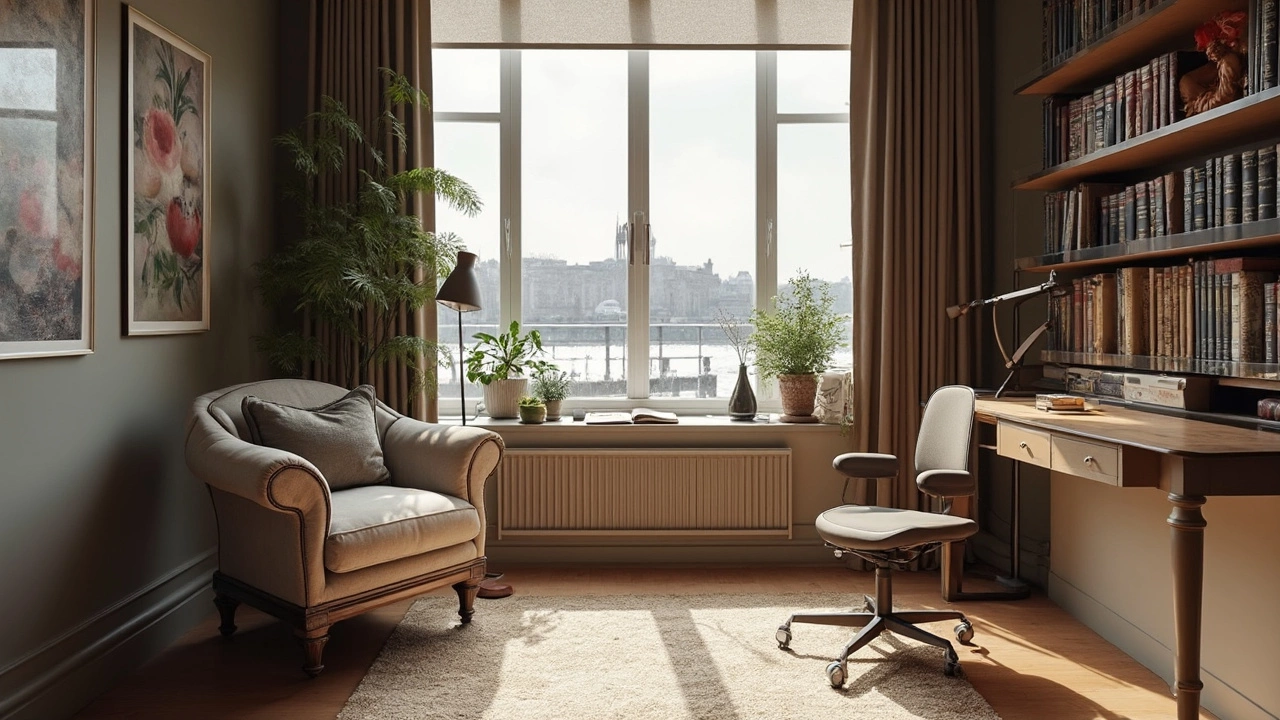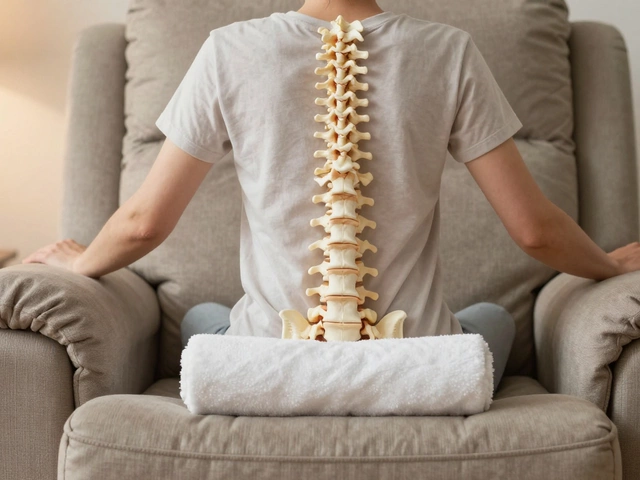You've probably pondered over whether to go for an office chair with or without arms. It's a bigger deal than it seems, right? A chair isn't just a place to park yourself for hours on end. It can make or break your productivity and comfort.
Let’s talk about arms on office chairs. They're like a pair of invited guests. They can provide a lovely balance of support and comfort. If you type like a demon or love a good arm stretch, they might save your shoulders a heap of pain. A lot of people swear by them for posture reasons. Imagine no more hunching over!
But, of course, there’s the flip side. Opting for no arms means easier mobility, which a lot of professionals prefer in a busy office space. It’s also a bonus if your office, like mine, is cozy, and squeezing in and out is a common feat.
- The Case for Armrests
- When Armrests Might Not Be Ideal
- Finding the Right Fit
- Enhancing Ergonomics
- Making the Decision
The Case for Armrests
Alright, let’s chat about why having an office chair with arms might be a great choice for you. Imagine you're typing away at your desk, lost in your work. What's awkwardly hovering? Your arms, if your chair doesn't have armrests. With armrests, your arms get a comfortable spot to land, reducing strain on your neck and shoulders. It’s like giving your arms a mini vacation between those epic typing sessions.
Armrests also come in handy when you need a breather. Lean back, rest your elbows, and you'll notice a huge difference in overall comfort levels. Those who struggle with long hours in front of screens—I’m looking at you, gamers and marathon-working-from-homers—often find that armrests make marathon sessions less of a literal pain.
Looking at the bigger picture, ergonomics experts are often big fans of armrests. According to studies, armrests can help maintain natural arm and wrist positions, which is a game-changer for preventing repetitive strain injuries like carpal tunnel syndrome. Armrests help distribute body weight evenly, which can boost comfort and even productivity.
Not all armrests are created equal, though. It’s crucial to shop smart. Look for adjustable options that align well with your desk and body height. Foam padding or soft covers add an extra layer of comfort and avoid 'armrest dents' in your forearms.
Oh, and a quick tip: measure your desk space. You don't want armrests bumping against the desk, which can get annoying fast. Consider ones that slide under the desk for easy storage and a cleaner look.
When Armrests Might Not Be Ideal
Okay, let’s face it, office chairs with armrests aren't always the golden ticket to comfort. Sometimes, they just don't fit the bill, and here's why.
If you're working in a tight space, like many home offices tend to be, those armrests can become tricky little nuisances. They can make it annoyingly hard to tuck your chair right under your desk. This creates a cramped seating position that might do more harm than good.
Some folks find armrests mess with their desk alignment. They need freedom to move quick and easy, especially if you’re hopping back and forth between different tasks or keyboards. Tripping over an armrest can slow you down, not to mention drive you nuts if you shift positions often.
Let’s not forget ergonomics—armrests that are too high or too low can lead to awkward postures. If they’re not adjustable, you might end up hunched or reaching awkwardly, which can cause unnecessary tension in shoulders and neck muscles.
Then there’s also the cost factor. If you're on a budget, a chair without armrests is often simpler and cheaper, providing decent support without extra bells and whistles. Plus, it often has a sleeker design, which might appeal if you're aiming for a minimalist look in your setup.
At the end of the day, it’s about balance. If armrests create more problems than they solve, it might be time to think about a chair that ditches them entirely or look for ones with adjustable features.

Finding the Right Fit
Getting the perfect office chair is a bit like finding the right pair of shoes. It needs to feel just right, but it’s not just about comfort—it's about nailing the best fit for your back, shoulders, and your work style.
Firstly, consider your workspace. If you’ve got one of those lean, mean setups, an office chair without arms lets you slide effortlessly under your desk, saving loads of space and giving you more freedom of movement. On the flip side, if your work involves a lot of stationary tasks, armrests could be your new best friend, offering needed support.
Dr. James Levine from the Mayo Clinic suggests,
"A well-fitted chair that sufficiently supports the lower back can drastically reduce back pain over time."It's clear that an ergonomic fit is key.
When considering chair arms, they should be adjustable. This means you can tweak them to be level with your desk, which helps keep your arms at a comfortable 90-degree angle—a must-do for long hours at the keyboard.
Here are some quick tips to find your perfect match:
- Check Adjustability: Height and tilt adjustments aren’t just fancy features. They’re essential for keeping your posture in check.
- Material Matters: Mesh might not look as plush, but it's a champ for breathability. If you’re hotter than a toaster, it’s worth considering.
- Test it Out: Don’t skip the try-before-you-buy step. Spend some time in the chair to see how it fits all the nooks and crannies of your body.
Some studies show that having a well-chosen chair with the right features can shave off stress and boost productivity by around 20%. It's pretty wild how a simple chair choice can amp up your work game, huh?
Enhancing Ergonomics
Ergonomics isn't just a fancy term—it’s your pal in making those long work hours a little more bearable. Whether your office chair has arms or is arm-free, there are simple tweaks that can make a world of difference.
First things first, let’s talk about height. Ideally, your feet should be flat on the ground and your knees at a right angle. Most chairs these days come with adjustable features, so use them! For those with a chair without arms, ensure the back support doesn't just hit mid-spine. A full backrest gives better spinal support.
If your chair boasts chair arms, adjust them so your forearms rest gently without lifting your shoulders. This simple action helps reduce strain and fatigue. Make sure there’s at least a 2-inch gap between the edge of your chair and your legs for good circulation.
Now, here’s a neat trick for both types of chairs: frequent breaks. Sitting continuously isn't natural, and your body will thank you for taking short, regular breaks. Try the 20-20-20 rule: every 20 minutes, look at something 20 feet away for 20 seconds.
Lastly, consider accessories. A footrest or a small cushion can add comfort, especially if you’re on the shorter side. And don’t shy away from adapting your workspace so everything you need is within arm’s reach. The goal is to avoid unnecessary stretching or bending.
| Feature | Ideal Adjustment |
|---|---|
| Seat Height | Feet flat on the ground, knees at 90 degrees |
| Armrest Height | Forearms should rest comfortably |
| Backrest Position | Full support of the spine |
| Distance from Desk | Close enough to prevent awkward reaching |
Remember, the chair is there to serve you, not the other way around. Little adjustments can lead to big changes in how you feel by the end of the day.

Making the Decision
Alright, so you’re standing at the crossroads deciding whether to get an office chair with or without arms. It’s like picking a side in a friendly debate—no wrong answers, just what’s right for you. Let's nail down how to make that call.
First up, think about how you spend your time at the desk. If you’re typing away at a keyboard all day, armrests might be your savior. They can help keep your arms at that lovely 90-degree angle, saving you from some serious wrist strain. But if you multitask a lot, moving between tasks around your workspace, a chair without arms might offer the mobility you need.
Let’s not forget about the space factor. If your office area is tighter than a tube sock, a no-arm chair might help you glide in and out more easily. Measure your desk height too. If it’s on the lower side, arms on your chair might just be a nuisance.
Now, budget time! Wallets don’t love an endless splurge. Typically, armless chairs are lighter on the purse strings. If you’re on a budget but still want some support, look for chairs with adjustable arms, so you get the best of both worlds.
Also, if you experience back pain or posture issues, consider consulting an ergonomic specialist. They might offer insights specific to your needs. Whether you go for that supportive hug of armrests or the airy freedom without them, choose wisely.
Remember, the choice isn't just about arms or no arms. It's about aligning your choice with your work habits, comfort needs, and space considerations. You've got this!







